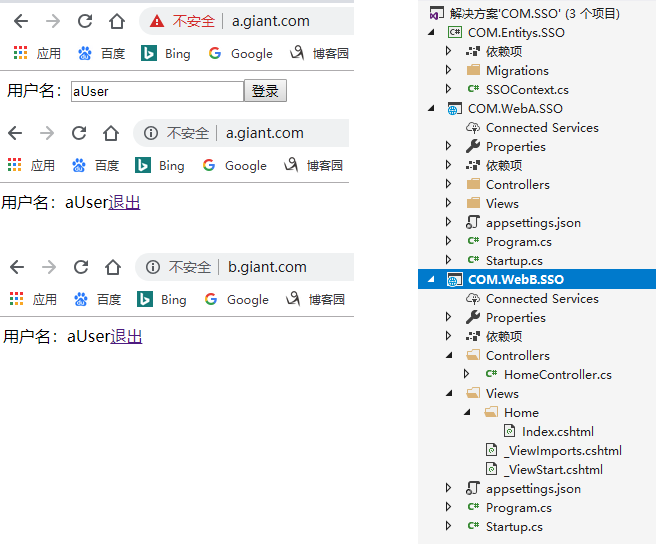在同一个域名下有很多子系统
如:a.giant.com b.giant.com c.giant.com等
但是这些系统都是giant.com这个子域。
这样的情况就可以在不引用其它框架的情况下,直接基于Cookie实现同域单点登录SSO
注:用ID4,OAuth,其它SSO框架也同样可以实现。本文不讨论。
为了简单表示。在这里登录页只输入一个用户名,然后登录
后台接收到登录名后,构建登录信息。然后登录
代码如下:
<form enctype="application/x-www-form-urlencoded" method="post"> @if (!User.Identity.IsAuthenticated) { <div><label>用户名:<input type="text" name="UserName" />label><button type="submit">登录button>div> } else { <div><label>用户名:@User.Identity.Namelabel><a href="/Home/SignOut">退出a>div> } form>
public class HomeController : Controller { public IActionResult Index() { return View(); } [HttpPost] public async TaskIndex(string UserName) { var claims = new List { new Claim(ClaimTypes.Name, UserName) }; var claimsIdentity = new ClaimsIdentity(claims, CookieAuthenticationDefaults.AuthenticationScheme); await HttpContext.SignInAsync(CookieAuthenticationDefaults.AuthenticationScheme, new ClaimsPrincipal(claimsIdentity)); return RedirectToAction("Index"); } public async Task SignOut() { await HttpContext.SignOutAsync(CookieAuthenticationDefaults.AuthenticationScheme); return RedirectToAction("Index"); } }
public class Startup { public void ConfigureServices(IServiceCollection services) { services.AddAuthentication(CookieAuthenticationDefaults.AuthenticationScheme).AddCookie(); services.AddMvc().SetCompatibilityVersion(Microsoft.AspNetCore.Mvc.CompatibilityVersion.Version_2_2); } // This method gets called by the runtime. Use this method to configure the HTTP request pipeline. public void Configure(IApplicationBuilder app, IHostingEnvironment env) { if (env.IsDevelopment()) { app.UseDeveloperExceptionPage(); } app.UseAuthentication(); app.UseMvcWithDefaultRoute(); } }
同样创建一个COM.WebB.SSO,写同样的代码实现登录。
但是这样只能A站点登录A系统,B站点登录B系统。两个系统相互独立
如果我们要实现aUser登录A系统后,B系统也自动登录aUser。
那么就可做如下改造
public void ConfigureServices(IServiceCollection services) { services.AddDbContext(option => { option.UseSqlServer(Configuration.GetConnectionString("SSO")); }); services.AddDataProtection() .PersistKeysToDbContext () //把加密数据保存在数据库 //.PersistKeysToFileSystem(new DirectoryInfo(@"\\server\share\directory\")) //把加密信息保存大文件夹 .SetApplicationName("SSO"); //把所有子系统都设置为统一的应用名称 services.AddAuthentication(CookieAuthenticationDefaults.AuthenticationScheme) .AddCookie(CookieAuthenticationDefaults.AuthenticationScheme,options=> { options.Cookie.Name = ".AspNet.SharedCookie";//设置统一的Cookie名称 options.Cookie.Domain = ".giant.com";//设置Cookie的域为根域,这样所有子域都可以发现这个Cookie }); services.AddMvc().SetCompatibilityVersion(Microsoft.AspNetCore.Mvc.CompatibilityVersion.Version_2_2); }
主要是增加了services.AddDataProtection配置
其中,数据加密配置保存方式现阶段asp.net Core支持
1。保存到文件:PersistKeysToFileSystem
2。保存到数据库:PersistKeysToDbContext
3。保存到Redis:PersistKeysToStackExchangeRedis
4。保存到Azure:PersistKeysToAzureBlobStorage
当然也可以自己实现存储方式,实现IXmlRepository
我这里实现了保存到数据库,代码如下:
public class SSOContext : DbContext, IDataProtectionKeyContext { public SSOContext(DbContextOptionsoption) : base(option) { } public DbSet DataProtectionKeys { get; set; } }
主要就是在DbContext基础上实现接口:IDataProtectionKeyContext
这里修改配置主要统一了数据加密方式与统一应用名称
这样其它子域的Cookie加密数据就能识别。
再配置统一的Cookie名称与写的域名为根域。
这样所有子域都能发现与识别此登录的Cookie信息
这样就可以实现一个系统登录,其它子系统都登录
一个子系统退出。其它子系统也都退出的功能
源代码下载地址:https://github.com/GiantLiu/COM.SSO

